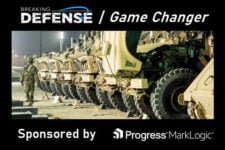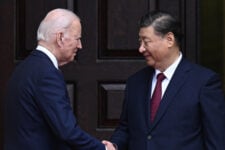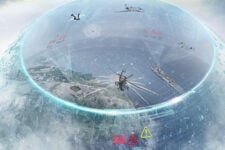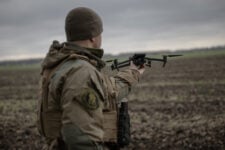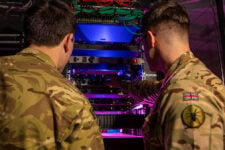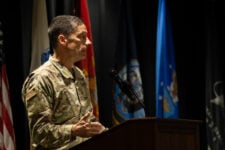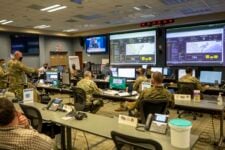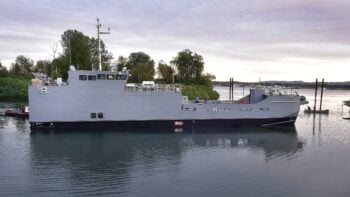![Lockheed Martin JADO from Space[1]](jpg/lockheed-martin-jado-from-space1-scaled.jpg)
Lockheed Martin JADO from space. Photo courtesy of Lockheed Martin.
In this Q&A with Lockheed Martin vice president and Chief Technology Officer Steve Walker, we discuss the company’s vision for urgent technology innovation called 21st Century Security (21CS), how it is transforming to support customers’ missions in a more complex battlespace, and why it is partnering with commercial industry to drive advanced capabilities for the defense industry.
Breaking Defense: What is Lockheed Martin’s 21CS vision?

Steve Walker vice president and Chief Technology Officer, Lockheed Martin.
Walker: We all know that the world is increasingly complex and threatening with issues across the globe. From a security standpoint, the pacing challenge we measure ourselves against is China, which has resources and massive investments in advanced technology. That means the U.S. must get a lot better at multi-domain operations and Joint All Domain Command and Control (JADC2).
When I first came to Lockheed Martin from DARPA about four years ago, I identified capabilities that we need to accelerate as a country and a strategy for how Lockheed Martin could deliver advanced, mission-focused technologies while leveraging emerging ones across multiple domains that would give us the edge and help deter war in the future.
That strategy accelerated when Jim Taiclet was named CEO a few months later. He understands that evolving threats require new ways of doing business and has been my biggest advocate in building research partnerships and integrating commercial investments to drive innovative capabilities for the best mission effects.
Those capabilities are laid out in our 21CS vision and include technologies such as AI, machine learning, autonomy and crewed-uncrewed teaming, and the 5G.MIL Unified Network Solutions (UNS) tactical mesh network. We just successfully demonstrated this hybrid 5G-tactical mesh network live in a multi-domain environment.
Lockheed Martin makes the best physical platforms in the world across land, air, sea, space and cyber. Through our 21CS strategy, we are collaborating to harness the best of commercial technology to drive capabilities that give military forces more range, speed, agility and a decision-making advantage.
Breaking Defense: Tell us some details about those capabilities you just mentioned.
Walker: 5G.MIL and advanced comms are about resilient communications, and being able to combine the low latency and high bandwidth advantages of 5G with our military advanced tactical data links that are highly secure to give our customers the best of both worlds.
If we can do that, we’ll have a resilient comms capability that can network our satellites, airplanes, and weapons systems across space, air, and maritime domains. That’s a critical technology for connecting the dots.
We think that AI and machine learning are such important areas that my team stood up the Lockheed Martin AI Center to help promulgate that technology across the company. We’ve built up a capability in-house to do the compute, the algorithm development, and to harness the algorithms that are out there and apply them to military applications using our ethical AI framework; all knowledge that we then share across Lockheed Martin.
So how does AI and machine learning play into the big picture? When we think about AI and machine learning, we don’t really think about machines making decisions. We think about machines helping humans make more informed decisions faster.
We also have significant investments in autonomy and crewed-uncrewed teaming. This is about building 5G.MIL, AI, machine learning, and communications technologies into some of our platforms so they can understand and communicate with each other in order to accomplish missions with one understanding.
This would produce what we’re referring to as ‘autonomy-enhanced JADC2’ that works across multiple domains and produces capabilities that are hard to defeat.
Another area is microelectronics or edge computing. If you’re going to have an autonomy-enhanced JADC2 system, you’re going to need edge processing. That means processing on platforms – not necessarily big platforms but smaller ones operating at the edge of the battlefield.
The processor in that edge device has to do the compute, processing, and in some cases the AI/machine learning. Another technology that’s critical to all of this is the processing or the microelectronics that go into these systems.
All those technologies are going to have to come together to help us enable JADC2.
Breaking Defense: What milestones have you reached in the execution of the 21CS vision to support DOD priorities, especially as a participant in exercises like Northern Edge?
Walker: We participated in Northern Edge ’23 in Alaska this summer, the first true joint force, multinational synchronization demonstrated at this scale across all services, operation levels, and domains. One of the things we demonstrated was our battle management command and control (BMC2) planning tools called DIAMONDShield. This is an important product for multi-domain battlespace management that helps with more centralized, upfront planning of a battle than we’ve done it in the past. Think about all the services coming together and using DIAMONDShield to produce a battle plan for a C2-type operation.
We were also able to use that tool and combine it with something we call the ‘Virtualized Aegis Weapon System’ that extended this planning capability out to the edge. It demonstrated a superior planning capability both centrally for more strategic operational use, and then also when connected to edge platforms through the virtual Aegis system.
That combination is something that can help INDOPACOM with their joint fires network. I commend INDOPACOM for pursuing JFN and, in my mind, being the first instantiation of something close to JADC2. I’m proud that Lockheed Martin, through our tech developments and 21CS solutions, is a full partner in that work with INDOPACOM.
Breaking Defense: Earlier you described some of the capabilities you’re looking for from commercial sector partners. Tell us about some of those collaborations.
Walker: Part of our 21CS strategy is collaboration with commercial companies who have made significant investments in many of these tech areas such as AI and communications. We have quite an array of large and small partners, some that we’ve announced and some that we haven’t, with whom we are focused on applying advanced technologies to military problems.
One example would be a recent demonstration we did with IBM Red Hat to determine how to get a processor onto an edge device like a small unmanned aerial vehicle and then have the ability to control this UAV — or multiple UAVs — in real time as the mission changes on the battlefield.
We worked with IBM Red Hat on what was needed in terms of size, weight, and power for the processor that we wanted to install, and they did it. We’ve shown great success in being able to modify the mission set that a series of UAVs would perform in real-time based on dynamic battlefield scenarios.
I’ll also mention our collaborations with GlobalFoundries and Intel on microelectronics, a critical technology that basically goes into everything we do. The partnership with Global Foundries that we announced in June is already paying off for both companies as we work to understand how microelectronics affect defense applications. We are on several of the government’s Tech Hubs around the country and are winning resources to pursue microelectronics development for national security.
These win-win collaborations help the microelectronics companies that have not traditionally been involved in the national security space better understand the market as they work with us on developing advanced capabilities. Those companies will then spin that knowledge and experience back into the commercial world where the security of microelectronics and chips is becoming increasingly important.
Breaking Defense: AI is not a new capability for Lockheed Martin. How do you ensure the ethical use of AI for national security?
Walker: We quickly embraced the Pentagon’s five principles of AI ethics – responsible, equitable, traceable, reliable, and governable – and developed an internal policy based on those five principles.
Our governance process includes an AI executive steering committee with an AI ethics subcommittee that regularly meets to understand and assess our AI work and ensure it abides by those five principles.
We’re also working on technologies that help the user understand what the AI is doing. Emphasizing the explainability of AI or explaining to the user why the AI is making its decisions, is critical.
Also important is coming up with a way to test and verify systems that are autonomous and might be using AI and machine learning to make decisions. Part of our investment in autonomy and crewed-uncrewed teaming is how we test these systems and validate/verify what they’re going to decide and what they’re going to do.
My overall view of AI and the ethics associated with it, especially in warfighting, is that AI shouldn’t be making the final decisions, humans should. However, AI can enable humans to receive and process data faster and more accurately than we could do on our own, for improved decision making.
It’s more about human-machine partnership than just machine understanding on its own what to do.



